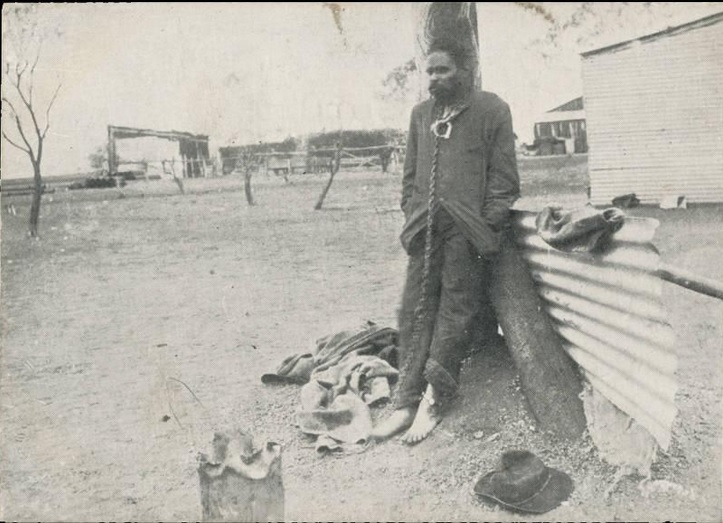-
Image is representational of Harlequin’s ordeal and is taken from a Postcard, titled, ‘A Local Lock-up. Aboriginal Prisoner Chained to a Tree.’
On 29th November 1840, Sargeant Henry Rose went to Irving’s station near Yackandandah to collect Harlequin who had been arrested on a warrant and detained. (1) (2)
Spelling in those days was phonetic so ‘Irving’ could be ‘Irvine or ‘Irwin’ or even ‘Ewing’ or ‘Huon’. Charles Huon had Baranduda station located 11 miles from Yackandandah.
Harlequin was handcuffed and put in a small collar chain, something like a dog chain fastened with a small padlock. Then, later on, on the 29th of November Sargeant Rose handed Harlequin to private Peter Byers and Private Rowley and they walked 10 miles and then secured the prisoner in a hut for the night.
The weather would have been hot and the landscape dry as the drought of 1837-42 was at its height. Fresh clean water would have been hard to source.
30th November they walked 36 miles to Reid’s station on the Ovens river where they stopped the night. This was likely to be David Reid at Carraragamungee station.
On 1st December Harlequin walked 30 miles to the Broken River police station.
Corporeal Abraham Kershaw of the mounted police was in charge of the Broken River station and he received the prisoner from Byers and Rowley and reported at the inquest that Harlequin appeared in good shape.
Michael Goodwin and Thomas Connock escorted Harlequin between Goulburn and Melbourne and delivered him to the watchhouse on 6th December in poor condition. Harlequin was not given any medical aid and on the 8th of December Merriman was brought into Harlequin’s cell by GA Robinson. Robinson wrote, ‘Merriman…cried bitterly on seeing him…and he gave kind offices…gave him water to drink.’ Harlequin died later that day. (3)
GA Robinson wrote of the cruel treatment saying Merriman had been apprehended in the same manner and had complained of being dragged with the chain around his neck and demonstrated the position in which he was forced to walk. (3)
GA Robinson visited Merriman in his cell and heard from others confined with him and who had been brought to Melbourne in the same manner as Harlequin and Merriman. GA Robinson wrote their arms, wrists, necks and ankles all bore evident marks of ill-usage such as would not be done to a horse. Some of the men had their skin torn and ulcerated by their bondage. (3)
Harlequin was buried at the grounds outside the gaol.
On Monday 28th December 1840 Merriman was released from gaol.
REFERENCES:
(1) Harlequin Inquest and account of his brutal treatment.
(2) Crime in the Port Phillip district 1835-51 / Paul R. Mullaly. Ormond, Vic. : Hybrid Publishers 2008, pages 353 -357. Examination of the inquest of Harlequin’s death.
(3) The Journal of GA Robinson; pg 236 Thursday 10th Dec 1840, pg 241 Saturday 2nd Jan 1841 and pg 240 Monday 28th Dec 1840.


